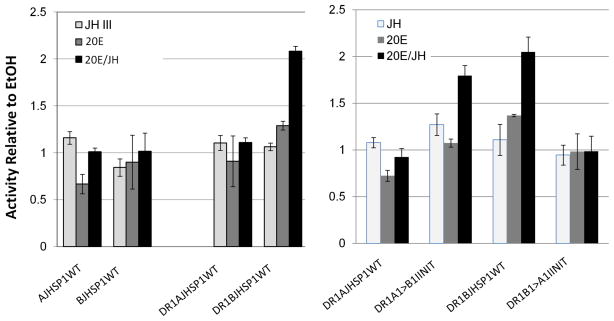Figure 5.
Normalized transcriptional activities of the wild type (WT) AJHSP1and BJHSP1 core promoter, each trimmed to include only the region from −41 to the first base of the translation start codon, and enhanced (or not, as indicated) by two copies of a 5′-placed DR1 motif. Also as indicated, the initiator of AJHSP1 was replaced with the five bases of the BJHSP1 initiator (DR1A1>B1INIT), and the initiator for the BJHSP1 was changed to be that of AJHSP1 (DR1B1>A1INIT). Shown relative to the EtOH control are means and standard error of the experimental treatments of 48 h exposure to 1 μM 20-hydroxy ecdysone (“20E”), 100 μM juvenile hormone III (“JH III”), or a combined treatment of the two hormones at these concentrations (“20E/JH”). Experiment-wise ANOVA was significant at p < 0.01. The wild type AJHSP1 core promoter, enhanced by DR1 (DR1AJHSP1WT), was not significantly affected by hormone treatment (p > 0.05), while the DR1BJHSP1WT activity was significantly induced by cotreatment with 20E and JH III, as compared to treatment with only 20E (p<0.05). However, when the initiator motif of the two promoters were exchanged (INIT), the DR1BJHSP1 promoter lost hormone responsiveness (p>0.05), while the DR1AJHSP1 promoter showed significantly more activity by cotreatment with 20E and JH III, than the treatment with 20E alone (p < 0.05).

